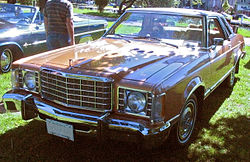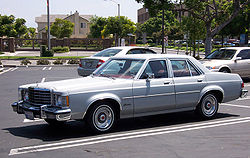Ford Torino
  |
|---|
| The Ford Torino is an intermediate automobile produced by the Ford Motor Company for the North American market between 1968 and 1976. The car was named after the city of Turin (Torino, in Italian), which is considered the Detroit (primary automobile production city) of Italy. The Torino was initially an upscale version of the intermediate sized Ford Fairlane, which Ford produced between 1962 and 1970. After 1968, the Fairlane name was retained for the base models with lower levels of trim than those models which wore the Torino name. During this time, the Torino was considered a subseries to the Fairlane. By 1970 Torino had become the primary name for Ford's intermediate, and the Fairlane was now a subseries of the Torino. In 1971 the Fairlane name was dropped altogether and all Ford intermediates were called Torino. This name was one of several originally proposed for the Mustang while in development.The Torino was essentially a twin to the Mercury Montego line. |
 |
|---|
| Most Torinos were conventional cars, and generally the most popular models were the 4-door sedans and 4-door hardtops. However, Ford produced some high-performance versions of the Torino by fitting them with large powerful engines, such as the 428 cu in (7.0 L) and 429 cu in (7.0 L) "Cobra-Jet" engines. These cars are classified as muscle cars. Ford also chose the Torino as the base for its NASCAR entrants, and it has a successful racing heritage. |
 |
 |
|---|---|
 |
 |
 |
 |
 |
 |
|---|---|
 |
|
 |
  |
 |
|---|
| In 1968 Ford Motor Company introduced its intermediate line with a new body and new styling. Along with the new body and styling came the new upscale series Torino. The Fairlane name continued to be used for lower level models, and the Torino was considered a sub-series to the Fairlane during this time. The 1968 Fairlane and Torino used the same wheelbases as its 1967 predecessor: 116 in (2,946 mm) on 2- and 4-door models, and 113 in (2,870 mm) for station wagon models. Styling was all new for the 1968 Fairlane/Torino, and it was drastically changed from the 1967 models. The new intermediate had grown in size and weight, and a new fastback model was added. The front fascia featured a full width recessed grille, with horizontal quad headlights placed at the outer edges. Horizontal dividing bars were featured in the grille depending on the model. |
|
|
||||||||||||||||||||||||||||||
|---|---|---|---|---|---|---|---|---|---|---|---|---|---|---|---|---|---|---|---|---|---|---|---|---|---|---|---|---|---|---|---|
 |
 |
||||||||||||||||||||||||||||||
 |
 |
||||||||||||||||||||||||||||||
| The 1969 Fairlane/Torino saw few cosmetic changes, but there were quite a few performance oriented changes. Ford performed the typical minor styling adjustments, but overall the 1969 models were similar to the 1968 models. The grille was revised slightly, and now had a more prominent centre dividing bar, while the taillights were more square in shape than the 1968 units. All models above the Fairlane, had an aluminium dividing bar that ran across the rear panel, between the taillights and inline with the reverse lights on SportsRoof models. |
|---|
| For 1970, the Torino now became the primary model and the Fairlane was a sub-series of Torino. Ford moved away from emulating the boxy lines of the full-size Fords to a completely new body for the 1970 Torino/Fairlane line influenced by coke bottle styling. Just as tailfins were influenced by jet aircraft of the 1950s, stylists such as Ford stylist Bill Shenk who designed the 1970 Ford Torino were inspired by supersonic aircraft with narrow waists and bulging forward and rear fuselages needed to reach supersonic speeds |
 |
 |
|---|---|
 |
 |
 |
 |
| For the 1971 model year, Ford limited changes to its intermediate line to minor revisions. The biggest change for 1971 was the decision to drop the Fairlane name from the intermediate line-up all together; the Falcon name would also not return for 1971. The Torino line-up consisted of 14 models. The base model was now the "Torino", available as a 2-door hardtop, 4-door sedan and 4-door station wagon. Next was the mid-level "Torino 500", available as a 2-door hardtop and SportsRoof, 4-door sedan and hardtop and a 4-dr station wagon. The top of the line Torino remained the "Torino Brougham", available as a 2-door and 4-door hardtop, while the "Torino Squire" remained the station wagon equivalent to the Brougham. The "Torino GT" was offered as a 2-door SportsRoof and convertible, while the "Torino Cobra" was still only available as a 2-door SportsRoof. |
|---|
|
For 1972, the Torino was redesigned using many characteristics carried over from the previous generation. The 1972 Torino styling emphasized the "long hood short deck" look as well as coke bottle styling more than ever before. The most radical change was a large eggcrate grille in an oval opening on Gran Torinos. |
 |
 |
|---|---|
 |
 |
 |
 |
 http://sportives-autos02.forumactif.com/t167-photos-de-ford-torino |
 |
|---|---|
 http://hotwheels.wikia.com/wiki/'69_Ford_Torino_Talladega |
 |
 http://retrocarsmania.blogspot.de/2011/02/ford-torino.html |
 |
        |
||
|
||
        |

 First generation
First generation









 HOME;
HOME;






